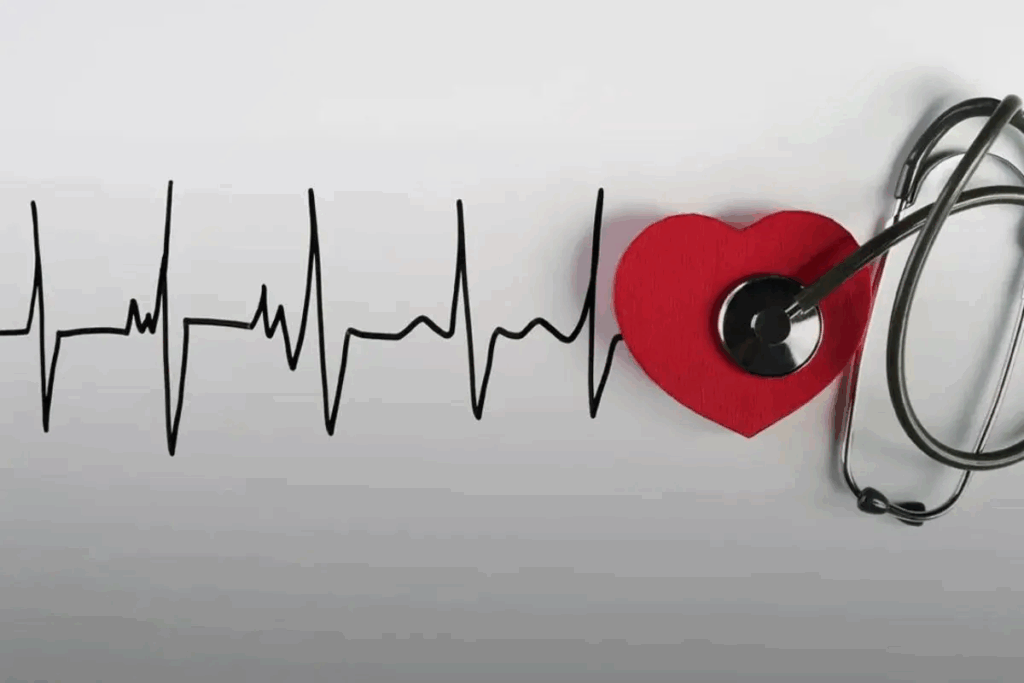Last Updated on October 31, 2025 by Batuhan Temel

At Liv Hospital, we understand the importance of knowing about antiarrhythmic medications. Sodium channel blockers are key in treating heart rhythm problems.
Learn class 1a antiarrhythmics and how they differ from class 1b medications.
We will look at the differences between Class 1A and Class 1B antiarrhythmics. Both are sodium channel blockers but work differently. Class 1A drugs like quinidine and procainamide make the action time longer. On the other hand, Class 1B drugs like lidocaine and mexiletine work on specific heart areas and shorten the action time.
Knowing these differences helps us treat heart rhythm problems better. Our aim is to give clear, evidence-based advice that puts patients first.

The heart’s rhythm is vital. When it goes wrong, the results can be serious. Cardiac arrhythmias, or irregular heartbeats, affect many people. They can lower a person’s quality of life and increase their risk of death.
These irregular heartbeats happen when the heart’s electrical system gets disrupted. This can be due to heart disease, imbalances in electrolytes, or some medications.
Arrhythmias are divided based on where they start and how they affect the heart rate. Supraventricular arrhythmias start above the ventricles. Examples include atrial fibrillation and supraventricular tachycardia. Ventricular arrhythmias start in the ventricles. This includes ventricular tachycardia and fibrillation.
Antiarrhythmic medications are key in treating arrhythmias. These drugs are sorted by how they work. This helps doctors understand their effects on the heart.
The Vaughan Williams system is a key way to sort antiarrhythmic drugs. It groups them into four classes: I, II, III, and IV. These classes are based on how the drugs affect the heart’s electrical system.
Class I antiarrhythmic drugs are split into IA, IB, and IC. This is based on their effect on sodium channels and how long the action lasts.
Knowing the Vaughan Williams system is vital for doctors. It helps them pick the right medication for each arrhythmia. This way, they can predict how well the drug will work and its possible side effects.

Class I antiarrhythmic agents are a group of medicines that work in a similar way. They block sodium channels. This helps manage heart rhythm problems by slowing down electrical signals in the heart.
These drugs block sodium channels. This action reduces sodium ions entering heart cells. It slows down the heart’s electrical activity and lowers its automaticity.
Class I antiarrhythmic drugs are divided into three types: 1A, 1B, and 1C. This division is based on how they affect the heart’s electrical activity and sodium channels.
Class I antiarrhythmic drugs are used to treat different heart rhythm issues. Their use depends on their type:
It’s important to know how Class 1A antiarrhythmics work. They help manage heart rhythm problems. This knowledge is key for their use in medical treatment.
Class 1A antiarrhythmics mainly block sodium channels. This stops sodium ions from entering heart cells. It slows down the heart’s electrical signals.
These drugs slow down the heart’s electrical signals. This helps keep the heart rhythm steady. It stops early electrical signals that can cause arrhythmias.
Class 1A antiarrhythmics also block potassium channels. This makes the QT interval longer on an ECG. But, it can also lead to dangerous heart rhythms.
These drugs also make the action duration longer. This helps with heart rhythm but needs careful watching.
In short, Class 1A antiarrhythmics work by blocking sodium and potassium channels. They affect the heart’s electrical signals and rhythm. Knowing how they work is vital for their safe use.
Quinidine, procainamide, and disopyramide are key players among Class 1A antiarrhythmic agents. These medications have been widely used in the management of various cardiac arrhythmias.
Quinidine is one of the oldest antiarrhythmic drugs, derived from the bark of the cinchona tree. It is known for its effectiveness in treating both supraventricular and ventricular arrhythmias. Quinidine’s mechanism of action involves sodium channel blockade, which slows conduction and prolongs the refractory period. Its use has declined due to side effects and the availability of more targeted therapies.
Procainamide is another Class 1A antiarrhythmic agent that has been used for various types of arrhythmias. It is useful in treating ventricular arrhythmias and certain supraventricular tachycardias. Procainamide’s pharmacological profile is similar to quinidine, with sodium channel blockade being its primary mechanism of action. It is often preferred in certain clinical scenarios due to its different side effect profile compared to quinidine.
Disopyramide is known for its unique anticholinergic effects and its ability to depress myocardial contractility. It is used in the treatment of ventricular arrhythmias and has been noted for its effectiveness in patients with hypertrophic cardiomyopathy. Disopyramide’s negative inotropic effect makes it a less favorable choice for patients with heart failure. Despite this, it remains a valuable option in specific clinical contexts.
In conclusion, quinidine, procainamide, and disopyramide are important Class 1A antiarrhythmic agents, each with its own set of properties and clinical applications. Understanding their unique characteristics is key for effective arrhythmia management.
In clinical practice, Class 1A antiarrhythmics are key in managing arrhythmias. They treat various heart rhythm disorders. This helps patients with specific cardiac conditions find relief.
Class 1A antiarrhythmics are great for treating supraventricular tachycardia (SVT). Quinidine and procainamide are often used. They slow down heart impulses, helping to restore a normal rhythm.
These drugs also manage ventricular arrhythmias, which are serious. Disopyramide is used for ventricular tachycardia. It blocks sodium channels, reducing heart muscle excitability and preventing dangerous arrhythmias.
Class 1A antiarrhythmics are valuable but have specific uses and warnings. They’re not for everyone, like those with advanced heart failure. It’s important to consider the benefits and risks before prescribing.
The table below shows the main uses, benefits, and warnings for Class 1A antiarrhythmics:
| Arrhythmia Type | Class 1A Antiarrhythmic | Indications | Contraindications |
| Supraventricular Tachycardia | Quinidine, Procainamide | Symptomatic SVT, recurrent SVT | Advanced heart failure, significant left ventricular dysfunction |
| Ventricular Arrhythmias | Disopyramide | Ventricular tachycardia, life-threatening arrhythmias | Structural heart disease, heart block |
Class 1B antiarrhythmics have special properties that help treat certain heart rhythm problems. We’ll look at how they work. This includes their ability to block sodium channels and their effect on damaged heart tissue.
Drugs like lidocaine block sodium channels in the heart. They do this more in areas that are damaged or not working right. These areas are where arrhythmias often start.
Class 1B antiarrhythmics mainly work on damaged heart tissue. This is key to their success. They focus on fixing the problem areas without harming the healthy parts of the heart.
These drugs make the action potentials shorter. This is true for special fibers in the heart and muscle cells. Shorter action potentials help prevent bad heart rhythms from coming back.
The effects of Class 1B antiarrhythmics on the heart are important. They help control irregular heartbeats and stop bad rhythms in the ventricles. Their ability to target damaged areas makes them useful in treating patients.
Class 1B antiarrhythmic medications, like lidocaine and mexiletine, are key in treating ventricular arrhythmias. They work well for certain arrhythmias because of their unique properties.
Lidocaine is a Class 1B antiarrhythmic agent given intravenously for ventricular arrhythmias. It blocks sodium channels, which helps in ischemic or depolarized tissues. Lidocaine’s quick start and short action are perfect for emergencies. It’s used in coronary care units or during cardiac surgery.
Mexiletine is an oral antiarrhythmic similar to lidocaine. It’s for long-term managing ventricular arrhythmias. Mexiletine’s oral form allows for ongoing treatment, great for patients needing long-term therapy.
While lidocaine and mexiletine are most used, other Class 1B drugs include phenytoin and tocainide. Though less common, they’re important in certain situations.
Knowing how these drugs work and when to use them is vital for doctors. It helps them make the best choices for treating ventricular arrhythmias.
In the world of heart rhythm treatments, Class 1B agents are key. They are mainly used for ventricular arrhythmias during heart attacks. Class 1B antiarrhythmics are vital in fighting dangerous heart rhythms.
Class 1B antiarrhythmics mainly treat ventricular arrhythmias. They work well on arrhythmias in the ventricles. This makes them a key part of heart care.
We use these drugs to target sodium channels in the heart. This helps keep the heart rhythm stable and lowers the risk of dangerous arrhythmias.
Class 1B antiarrhythmics are also used in acute myocardial infarction. Heart attacks raise the risk of ventricular arrhythmias. Drugs like lidocaine are given to prevent and treat these arrhythmias.
Their quick and effective action is critical in emergency care.
Class 1B antiarrhythmics are not good for supraventricular arrhythmias. They work best on ventricular tissue. This means they’re not the best choice for arrhythmias from above the ventricles.
This shows why it’s important to know the arrhythmia type before treatment.
In summary, Class 1B antiarrhythmics are essential for ventricular arrhythmias, mainly in heart attacks. Knowing their uses and limits helps doctors make better treatment choices.
Understanding the differences between Class 1A and 1B antiarrhythmics is key in managing heart rhythm problems. These two types of Class I antiarrhythmic drugs have unique properties. These properties affect how they are used in treatment.
Class 1A drugs, like quinidine and procainamide, stay in the body longer than Class 1B drugs. For example, quinidine stays in the body for about 6-8 hours. On the other hand, lidocaine, a Class 1B drug, leaves the body in 1-2 hours. This affects how often these drugs need to be taken and their use in different situations.
A clinical pharmacology expert noted,
“The way antiarrhythmic drugs are absorbed, distributed, and removed from the body is key to their effectiveness and safety.”
Class 1A drugs slow down electrical signals and make the heart take longer to recover. Class 1B drugs mainly work on damaged heart tissue and can make the heart’s electrical signal shorter. These differences guide their use in treating different heart rhythm problems.
Key Electrophysiological Differences:
Class 1A drugs are often used for heart rhythm problems above the ventricles and below. Class 1B drugs are mainly used for heart rhythm problems in the ventricles, like after a heart attack. The choice depends on the heart problem and the patient’s health.
Lidocaine is good for treating ventricular arrhythmias after a heart attack because it starts working fast and doesn’t last long.
Class 1A drugs can increase the risk of abnormal heart rhythms and prolong the heart’s electrical cycle. Class 1B drugs are generally safer, with fewer risks of abnormal heart rhythms. But, both types need careful monitoring and patient selection.
Safety Considerations:
When we talk about Class 1A and 1B antiarrhythmics, we must look at their side effects and safety. These drugs help manage heart rhythm problems but have different safety levels.
Class 1A drugs, like quinidine and disopyramide, can cause stomach problems and serious heart issues. They can make the heart’s rhythm worse and even lead to dangerous heart beats.
These drugs can also cause dry mouth and trouble with urination. It’s important to watch for these side effects closely.
Class 1B drugs, like lidocaine, are safer than Class 1A. They can make you dizzy or confused, but this is rare. Lidocaine is given through an IV, so doctors can watch you closely.
Mexiletine is taken by mouth and has similar side effects. It’s safer for the heart than Class 1A drugs.
Class 1A and 1B drugs can react badly with other medicines. This can lead to serious heart problems. Class 1A drugs can make heart rhythm problems worse when used with other drugs.
These drugs should not be used if you’re allergic to them or have certain heart problems. They’re also not good for people with severe heart failure or certain electrolyte imbalances.
It’s important to watch how Class 1A and 1B drugs work in your body. For Class 1A, doctors will check your heart rhythm often. They also watch for signs of lupus-like syndrome with procainamide.
For Class 1B, doctors look for signs of brain problems and liver issues. They will adjust your treatment to keep you safe and help you feel better.
It’s key to know the differences between Class 1A and 1B antiarrhythmics for good treatment. This article has shown how these two types of drugs work and when to use them.
Class 1A drugs, like quinidine and procainamide, slow down heart signals and make the heart take longer to recharge. They help with many heart rhythm problems. On the other hand, Class 1B drugs, like lidocaine, mainly treat heart rhythm issues that happen after a heart attack.
Choosing between Class 1A and 1B drugs depends on the heart problem, the patient’s health, and the heart’s condition. Knowing how these drugs work and their side effects helps doctors pick the best treatment.
In short, understanding the differences between Class 1A and 1B antiarrhythmics is vital. It helps doctors tailor treatments for heart rhythm problems. This way, we can make care better and improve patient results.
Class 1A antiarrhythmics are a type of heart medication. They block sodium channels in the heart. This slows down electrical impulses and makes the heart’s action last longer.
Class 1B antiarrhythmics also block sodium channels. But they work more on ischemic or depolarized heart tissue. They shorten the action duration, unlike Class 1A which prolongs it.
The Vaughan Williams system categorizes heart medications. Class I includes sodium channel blockers, like Class 1A and 1B antiarrhythmics.
Class 1A antiarrhythmics treat various heart rhythm problems. This includes atrial fibrillation and ventricular tachycardia.
Class 1A antiarrhythmics are used for both heart rhythm problems above and below the ventricles. Class 1B agents mainly treat ventricular arrhythmias, often after a heart attack.
Side effects of Class 1A antiarrhythmics include stomach issues and anticholinergic effects. They can also cause dangerous heart rhythms.
Class 1A antiarrhythmics have a longer half-life and are taken orally. Class 1B agents like lidocaine have a shorter half-life and are given intravenously.
You shouldn’t use these medications if you have severe heart block or significant QT prolongation. Also, if you’re allergic to the drug, avoid it.
Both classes can interact with other drugs. This includes antiarrhythmics, beta-blockers, and some antibiotics. These interactions can cause problems or reduce how well the medication works.
You’ll need regular ECGs to check the drug’s effect on your heart rhythm. This helps watch for signs of toxicity or dangerous effects.
National Center for Biotechnology Information. (2025). What Are Class 1A Antiarrhythmics and How Do. Retrieved from https://www.ncbi.nlm.nih.gov/books/NBK482322/
Subscribe to our e-newsletter to stay informed about the latest innovations in the world of health and exclusive offers!
WhatsApp us